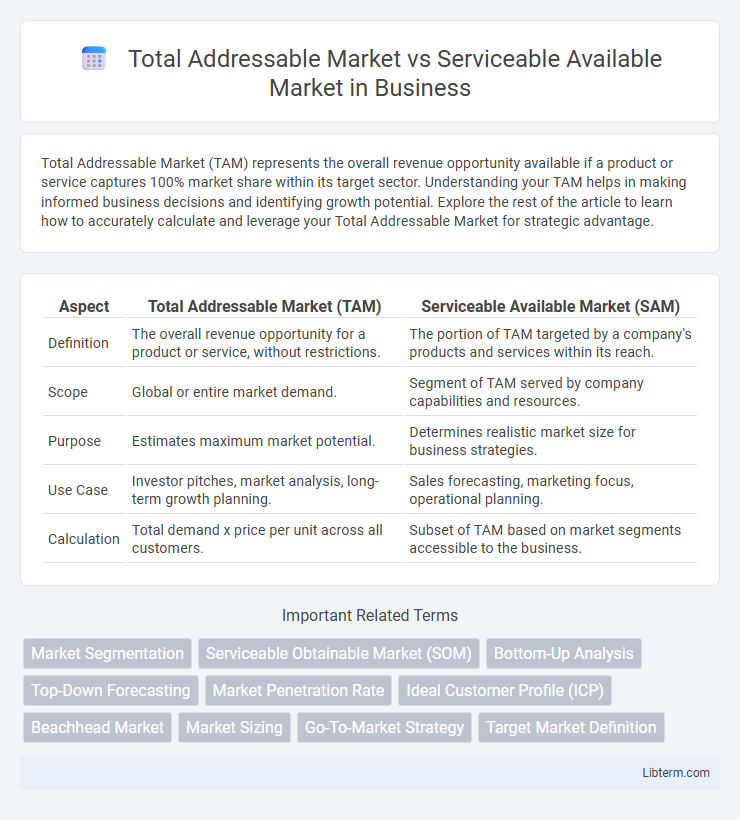Total Addressable Market (TAM) represents the overall revenue opportunity available if a product or service captures 100% market share within its target sector. Understanding your TAM helps in making informed business decisions and identifying growth potential. Explore the rest of the article to learn how to accurately calculate and leverage your Total Addressable Market for strategic advantage.
Table of Comparison
| Aspect | Total Addressable Market (TAM) | Serviceable Available Market (SAM) |
|---|---|---|
| Definition | The overall revenue opportunity for a product or service, without restrictions. | The portion of TAM targeted by a company's products and services within its reach. |
| Scope | Global or entire market demand. | Segment of TAM served by company capabilities and resources. |
| Purpose | Estimates maximum market potential. | Determines realistic market size for business strategies. |
| Use Case | Investor pitches, market analysis, long-term growth planning. | Sales forecasting, marketing focus, operational planning. |
| Calculation | Total demand x price per unit across all customers. | Subset of TAM based on market segments accessible to the business. |
Understanding Total Addressable Market (TAM)
Total Addressable Market (TAM) quantifies the entire revenue opportunity available for a product or service if it achieved 100% market share. Understanding TAM helps businesses evaluate the maximum scale of their target market and informs strategic decisions regarding product development and marketing investment. Accurate TAM estimation incorporates market size, customer segments, and geographic reach to provide a comprehensive market landscape.
Defining Serviceable Available Market (SAM)
Serviceable Available Market (SAM) represents the segment of the Total Addressable Market (TAM) that a company can realistically target with its products or services, considering current capabilities and geographic reach. SAM focuses on the portion of the market demand that aligns with a business's specific offerings and operational constraints. Accurately defining SAM helps businesses prioritize resources and tailor marketing strategies to maximize sales potential within accessible market boundaries.
TAM vs SAM: Key Differences
Total Addressable Market (TAM) represents the overall revenue opportunity available if a product or service achieves 100% market share in a specific industry. Serviceable Available Market (SAM) narrows this scope to the segment of TAM targeted by a company's products or services, factoring in geographic, regulatory, or technological constraints. Understanding TAM versus SAM is crucial for strategic planning and investment decisions, as TAM defines broad potential while SAM reflects realistic, addressable revenue within operational reach.
Importance of TAM in Market Strategy
Total Addressable Market (TAM) represents the entire revenue opportunity available for a product or service, providing a comprehensive overview of market potential. TAM is crucial in market strategy as it helps businesses prioritize resource allocation, set realistic growth targets, and attract investors by demonstrating the scale of opportunity. Understanding TAM ensures companies focus on long-term strategic planning rather than just immediate sales, enabling sustainable market expansion.
Why SAM Matters for Growth Planning
Serviceable Available Market (SAM) defines the portion of the Total Addressable Market (TAM) that a company can realistically target based on its product or service capabilities, geographic reach, and operational constraints. Understanding SAM is crucial for accurate growth planning because it helps businesses allocate resources effectively, set achievable sales targets, and develop targeted marketing strategies. Focusing on SAM ensures alignment between market opportunity and company capabilities, driving sustainable expansion and maximizing return on investment.
Calculating Total Addressable Market
Calculating Total Addressable Market (TAM) involves estimating the total revenue opportunity available for a product or service if it achieved 100% market share. This process typically requires analyzing industry reports, demographic data, and market segmentation to quantify potential customers and their purchasing power within the relevant sector. Accurate TAM calculation informs strategic business decisions by defining the upper boundary for market potential and guiding resource allocation.
Estimating Your Serviceable Available Market
Estimating your Serviceable Available Market (SAM) requires identifying the segment of the Total Addressable Market (TAM) that your products or services can realistically reach based on factors like geography, target demographics, and distribution channels. Precise SAM estimation involves analyzing market data, customer needs, and competitive landscape to quantify the potential revenue within your business's operational scope. Accurate SAM assessment guides strategic planning, investment decisions, and efficient resource allocation by focusing on achievable market opportunities.
Common Mistakes in TAM and SAM Analysis
Common mistakes in Total Addressable Market (TAM) and Serviceable Available Market (SAM) analysis include overestimating the TAM by failing to define clear geographical or demographic boundaries, which leads to inflated market size projections. Another error is confusing SAM with TAM, where companies incorrectly treat their reachable market segment as the entire market opportunity, skewing resource allocation and growth expectations. Ignoring competitive dynamics and customer adoption rates in SAM assessments often results in unrealistic forecasts and poor strategic decisions.
TAM and SAM in Investor Presentations
Total Addressable Market (TAM) represents the overall revenue opportunity available if a product or service achieves 100% market share, providing investors a macro-level view of growth potential. Serviceable Available Market (SAM) narrows this focus to the segment of TAM that is targeted by a company's products and services within its reach, highlighting realistic revenue potential and operational focus. Clearly presenting TAM and SAM in investor presentations demonstrates market understanding and scalability, making a compelling case for strategic investment.
Choosing the Right Market Metric for Your Business
Choosing the right market metric between Total Addressable Market (TAM) and Serviceable Available Market (SAM) depends on your business goals and growth stage. TAM represents the overall revenue opportunity for your product or service if 100% market share is achieved, while SAM reflects the segment of TAM targeted by your current capabilities and distribution channels. Prioritizing SAM over TAM helps startups focus on realistic, reachable customers and optimize resource allocation for market entry and expansion.
Total Addressable Market Infographic

 libterm.com
libterm.com